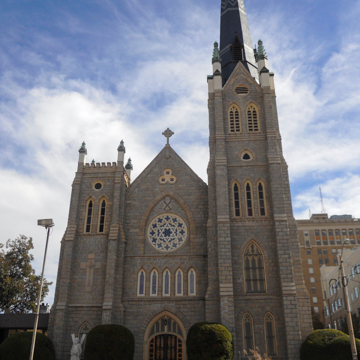The first Catholic Mass was held in Little Rock in 1830, but the city’s first Catholic Church was not built until nearly a decade later. Until 1843, the Catholic Church in Arkansas was under the Diocese of St. Louis, and when Little Rock achieved its own diocese, its first bishop, Andrew Byrne, purchased property at 2nd and Center streets, and the first Cathedral of St. Andrew was erected in 1845. By the late 1870s, growth of the Catholic community necessitated a larger building. Construction on Little Rock architect Harding’s Gothic Revival design began in 1878, and although the cathedral was dedicated in 1881, the 220-foot-tall tower was not completed until 1887. The church delayed completing the tower until after the nearby Masonic Temple was completed (since demolished) to ensure that the spire would make the church the tallest building in the city. Constructed entirely of granite quarried from nearby Fourche Mountain, the cathedral is designed in the shape of a Latin cross—in the tradition of European cathedrals—with the facade dominated by two towers. The smaller tower reatures a parapet with battlements, while the taller tower, topped with a spire crowned with a cross, houses the largest bell in Arkansas. Pointed arches are employed throughout the building to accommodate the cathedral’s large 13 × 28–foot stained glass windows by the New York studio of Franz Mayer of Munich. While the cathedral’s exterior remains largely unchanged, the interior has undergone several renovations, and many of the elaborate original features have been removed. Although no longer the tallest structure in the city, St. Andrew’s towering spire retains an important place in Little Rock’s skyline. The cathedral is the oldest religious structure in the city.
You are here
Cathedral of St. Andrew
If SAH Archipedia has been useful to you, please consider supporting it.
SAH Archipedia tells the story of the United States through its buildings, landscapes, and cities. This freely available resource empowers the public with authoritative knowledge that deepens their understanding and appreciation of the built environment. But the Society of Architectural Historians, which created SAH Archipedia with University of Virginia Press, needs your support to maintain the high-caliber research, writing, photography, cartography, editing, design, and programming that make SAH Archipedia a trusted online resource available to all who value the history of place, heritage tourism, and learning.






